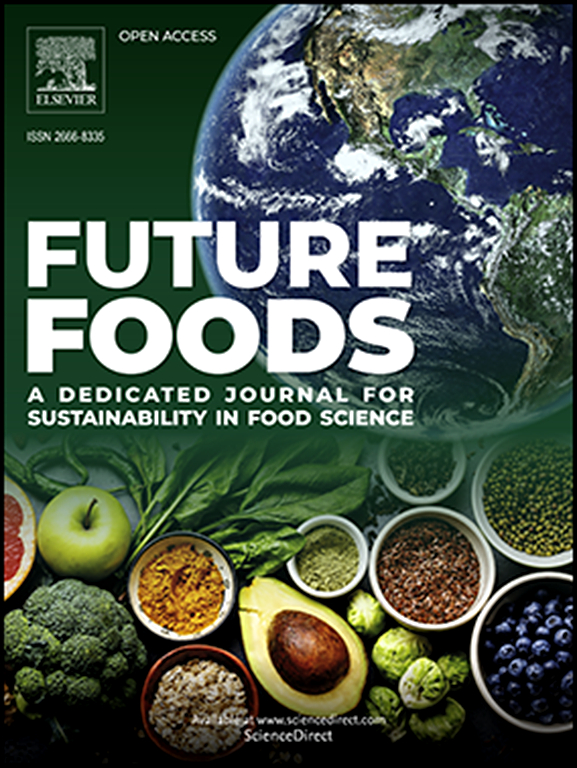Tailored bioprocessing of brewers’ spent grain for the development of upcycled plant-based spoonable snacks
IF 8.2
Q1 FOOD SCIENCE & TECHNOLOGY
引用次数: 0
Abstract
Reintegration of brewers' spent grain (BSG) into the food system remains a challenge. In this study, BSG underwent enzyme hydrolysis with Ondea Pro, followed by fermentation with Lactiplantibacillus plantarum POM1 or Pediococcus claussenii DSM 14800. Both bacterial strains exhausted C6 sugars and lowered the pH to below 4. This bioprocessing approach increased the total polyphenol, antioxidant capacity, and free amino acid content in a strain-dependent manner. Enzyme hydrolysis contributed to an increase in low molecular weight dietary fibre content, while fermentation reduced the abundance of volatile organic compounds with off-flavours such as malty, grassy and pungent, and increased fruity, citrus, sour and sweet aroma compounds. Unprocessed (control) and bioprocessed BSG were then used as ingredients for semi-solid -spoonable snack prototypes with or without strawberry purée. A consumer sensory study involving 119 untrained participants showed higher liking for unprocessed samples, likely due to the bitter taste of the bioprocessed samples. However, adding purée increased the liking in all cases, while only fermentation could enhance the presumably desired aroma notes and reduce the presumably undesired cereal aroma and flavour. These findings suggested that tailored bioprocessing, informed by sensory data, could support the development of functional upcycled food with a cleaner ingredients label.

量身定制的生物处理啤酒酿造者的废粮,以开发升级回收的植物为基础的勺状零食
将酿酒商的废粮(BSG)重新纳入食品系统仍然是一个挑战。在本研究中,BSG先用Ondea Pro酶解,然后用植物乳杆菌POM1或克氏Pediococcus claussenii DSM 14800发酵。两种细菌都耗尽了C6糖,并将pH值降至4以下。这种生物处理方法以菌株依赖的方式增加了总多酚、抗氧化能力和游离氨基酸含量。酶水解增加了低分子量膳食纤维的含量,而发酵减少了挥发性有机化合物的丰度,这些化合物带有麦芽、草味和辛辣味,并增加了水果、柑橘、酸和甜的香气化合物。然后,未加工的(对照)和生物加工的BSG被用作半固体勺状零食原型的原料,其中有或没有草莓pursame。一项涉及119名未经训练的参与者的消费者感官研究显示,他们更喜欢未经加工的样品,可能是由于生物加工样品的苦味。然而,在所有情况下,添加pursame都增加了人们对谷物的喜爱,而只有发酵可以增强人们可能想要的香气,减少人们可能不想要的谷物香气和味道。这些发现表明,根据感官数据定制的生物加工可以支持开发具有更清洁成分标签的功能性升级食品。
本文章由计算机程序翻译,如有差异,请以英文原文为准。
求助全文
约1分钟内获得全文
求助全文
来源期刊

Future Foods
Agricultural and Biological Sciences-Food Science
CiteScore
8.60
自引率
0.00%
发文量
97
审稿时长
15 weeks
期刊介绍:
Future Foods is a specialized journal that is dedicated to tackling the challenges posed by climate change and the need for sustainability in the realm of food production. The journal recognizes the imperative to transform current food manufacturing and consumption practices to meet the dietary needs of a burgeoning global population while simultaneously curbing environmental degradation.
The mission of Future Foods is to disseminate research that aligns with the goal of fostering the development of innovative technologies and alternative food sources to establish more sustainable food systems. The journal is committed to publishing high-quality, peer-reviewed articles that contribute to the advancement of sustainable food practices.
Abstracting and indexing:
Scopus
Directory of Open Access Journals (DOAJ)
Emerging Sources Citation Index (ESCI)
SCImago Journal Rank (SJR)
SNIP
 求助内容:
求助内容: 应助结果提醒方式:
应助结果提醒方式:


